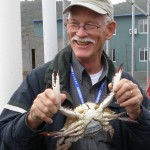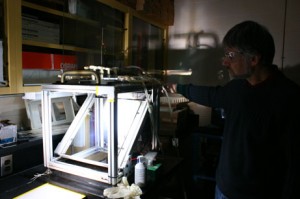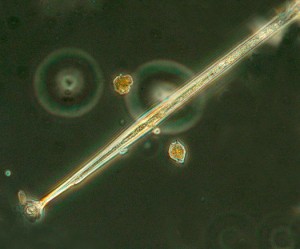The first Earth Day developed as a grassroots movement with teach-ins focused on the environment. I focused on a career in ecology, but Earth Day inspired my commitment to solutions for human impacts on the biosphere. In the ivory tower of Berkeley, applied research was then portrayed as a lower calling to “pure research.” But I was committed to merging fundamental ecology applied to human impacts, now a hallmark of SERC research.
Click to continue »
Ecology
...now browsing by category
From the director: Earth Day and the next 40 years
Thursday, April 22nd, 2010Ecologist examines deer diet and its impact on invasive plants
Tuesday, March 23rd, 2010— Produced by John Barrat, for Smithsonianscience.org
Hypoxic waters: Researching beyond the surface to understand the impact on fisheries
Friday, March 19th, 2010
Two summer interns measure the water's dissolved oxygen concentrations. Water is typically considered hypoxic if oxygen concentrations are below 2mg/L. Photo: Courtney Richmond
In coastal waters around the world there are more than 500 hypoxic zones. These are areas where dissolved oxygen concentrations are so low that they threaten fish, invertebrates and aquatic food webs. Some fish manage to escape hypoxic areas, but oysters, clams and other sessile creatures are simply stuck.
Hypoxia makes the evening news when there’s a noticeable fish kill. However many of its effects are more subtle. Individuals that fail to escape low oxygen zones can suffer mortality or reduced growth and reproduction. Creatures that flee can become easy targets for fishermen and predators.
Click to continue »
Phragmites australis: Genetic analysis reveals the promiscuous nature of the invasive reed
Friday, March 12th, 2010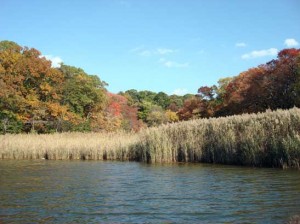
The non-native strain of Phragmites australis dominates many Chesapeake Bay wetlands. Photo Melissa McCormick.
Click to continue »
Plants, climate change and the importance of being curious, an interview with Bert Drake
Thursday, February 25th, 2010If you’re looking for a good conversation about science, history or life – talk to Bert Drake. He’s a plant physiologist and renaissance man who’s been with the Smithsonian Environmental Research Center for nearly four decades. Drake retired in January, but will continue his investigations as an emeritus scientist. We caught up with him before he took well-deserved vacation.
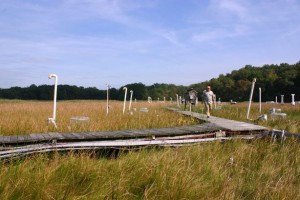
Drake's research unfolds at the Kirkpatrick Marsh, located in Maryland on a subestuary of the Chesapeake Bay.
How did you earn a living before you became a scientist?
I was a drummer in a jazz band, a ski guide, the host of a jazz radio program and a high school science teacher.
How did you get drawn to the world of plant physiology?
Nature has always fascinated me and science is about discovering how nature works. I grew up in northern Maine. My father was a barber, but loved the outdoors. I was outside year-round: skiing, canoeing, trapping animals, fishing and taking photos. I knew I wanted to do something connected with biology. I became a science teacher, but it wasn’t until I attended a summer course in ecology that I wanted to get inside a lab and practice science.
In science you almost always get an approximation of an answer because an experiment is only an approximation of reality.
The Beast and the big “What if?”
Friday, February 19th, 2010For many SERC scientists, field research comes to a halt in the winter. Some manage to head off to the tropics to investigate invasive species or mangroves, but not photobiologist Pat Neale. Neale and his assistants are spending a good part of their time these days in his lab with the Beast.
The Beast does not bite, but if you look at it the wrong way it will hurt you. In fact it can char your corneas if you’re not careful. That’s because it reflects and filters ultraviolet light. UV rays are invisible to the naked eye, but are high in energy and potentially damaging to animals and plants. As a photobiologist Neale studies how UV rays affect aquatic environments and the organisms that live in them.
Click to continue »
Forests are growing faster, climate change most likely new steroid
Monday, February 1st, 2010by Tina Tennessen
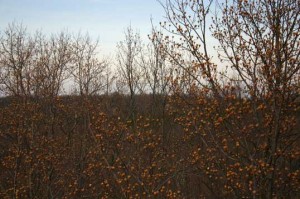
Liriodendron tulipifera, or tulip poplar, is a common tree in the temperate forests surrounding the Smithsonian Environmental Research Center. Other species include sweetgum, American beech, and southern red oak. Photo: Kirsten Bauer.
Click to continue »
No buzz yet, but we’re preparing for the little honey makers
Friday, January 29th, 2010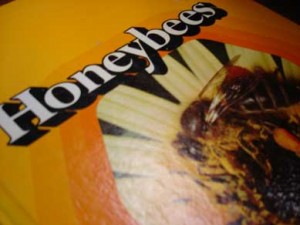
You can't be a beekeeper without doing your homework. McDonald has been reading up on bees to prepare for the new colonies.
Karen McDonald is not one to sit idly by while a fellow member of planet Earth struggles. McDonald is an educator and the Smithsonian Environmental Research Center’s outreach coordinator. This week she and Elio Cruz prepared three beehives that – come summer – will be full of the flying honey machines. Cruz is a technician at the National Museum of Natural History. He works in the museum’s O. Orkin Insect Zoo.
Click to continue »
From the Bay of Bengal, a dinoflagellate makes its way to the Smithsonian
Friday, January 22nd, 2010It’s not an exaggeration to say Hedrick was ecstatic when she peered into her inverted phase contrast microscope and found Amphisolenia quadrispina floating in her sample. “For 20 years I’ve been hoping to see something like this,” she said. A. quadrispina has a unique long, thin shape that resembles a stick, more than it does other dinoflagellates. It’s huge too — between 600 to 700 microns, which is still smaller than the tip of a needle, but large by phytoplankton standards.
Click to continue »
Intern Logs: Methanogenesis and nail polish
Tuesday, October 27th, 2009Q&A with David Gonzalez, 2009 Summer Intern
Major: Evolution, Ecology and Biodiversity
School: University of California-Davis, Class of 2011
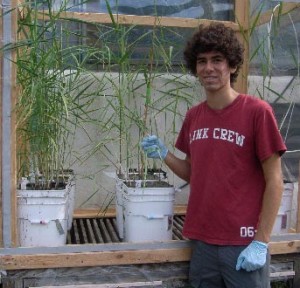
Intern David Gonzalez poses with some of his Phragmites australis plants
What drew you to the Smithsonian Environmental Research Center?
The big-picture research that the scientists do here interested me, particularly the experiments relating to global climate change. Among other things, scientists of my generation are going to have to understand how climate change will impact organisms. We talk about it a lot in my classes, so it was cool to have the opportunity to have hands-on experience exploring some of these issues as an undergrad.
You were here for ten weeks. What was your research project about?
I worked on a global change project that examined the relationship between microbes in the soil and Common Reed, or Phragmites australis. Through a process called methanogenesis, the microbes produce methane, a powerful greenhouse gas, which the plants help to emit into the atmosphere. Because Phragmites australis is found in wetlands worldwide, it’s important to look at how its methanogenesis rates might be affected by global change. Basically we wanted to see if rising CO2 and nitrogen levels exacerbate the problem of methane emissions. So I spent the summer growing Phragmites australis under conditions of elevated CO2 and nitrogen and then measured the response of the microbes and plants.
Do you feel like you spent your summer being an active scientist?
Half of the summer I felt like a scientist; the other half I felt like a gardener. There were a lot of day-to-day chores like watering the plants, counting them, giving them fertilizer, and weeding them. I had to make sure these plants grew to the best of their ability in the short time we had to grow them.
So you learned about the challenges and realities of doing science?
A lot of things I learned this summer relate to how many little things go into doing scientific research – from going out and buying fuses for a machine when it broke down, to purchasing nail polish at a drug store so we could take a peel from a leaf to count stomatal density.
What exactly did you do with nail polish?
We used it in some pilot studies. You apply nail polish to the leaf, let it dry, put scotch tape on it, and then pull it off. This creates a kind of caste of the leaf that you can put on a microscope slide so you can examine a leaf’s cellular structure. For instance, we can go through and count the guard cells, which lets us figure stomatal density and helps us understand how the leaf is responding to the treatments we applied.
You were in the biogeochemistry lab. Did you interact much with the other labs at SERC?
Yeah, one of the great things about SERC is that you’re surrounded by scientists with all these different areas of expertise. I got a lot of help from the forest ecology lab; they let me use some of their instruments for measuring leaf area. But we also got to go on lab exchanges. I spent a day on the water with the “Crab Lab;” I helped them catch and tag blue crabs. And then I also spent a number of evenings setting up mouse traps in the forest with a friend who was interning in the Terrestrial Ecology Lab. In general, we were encouraged to find out what the other labs were up to, which I often did just by talking with the other interns.
What are the dorms like?
The Green Village is awesome. It has a kitchen, a common area and feels like a nice cozy dorm.
How much independence did you have?
Usually you put in eight hours of work a day; occasionally you work more. After that though, you’re free. We cooked dinners together in the evenings. Some of the interns had a garden with a behemoth of a basil plant – that made for a great pesto party. And then we spent weekends exploring the East Coast. I saw fireworks in Washington, DC, on the Fourth of July; camped in Shenandoah National Park; and swam in the Atlantic Ocean.
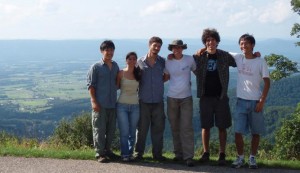
SERC's summer interns on a day-trip to the Shenandoah Valley
Was it difficult to get around?
A lot of the interns had cars. That was something I was worried about in the beginning, but everybody turned out to be really friendly. If you needed groceries, there were always people going to the grocery store. If you wanted to visit Washington, DC, it was easy to round up people to hit the Smithsonian Museums. The weekend excursions were great.
You’ll graduate in 2011. How do you want to use the knowledge you’ve gained here at SERC?
I’m definitely planning on doing more scientific research – maybe related to climate change, maybe not. Something that I’m very interested in is communicating the importance of environmental science to the general public and to policy makers. I want to be able to convey why it’s important to think about things like climate change, where your food comes from, farming practices, carbon emissions and things like that. That’s sort of my long-term interest – which I hope will go hand-in-hand with my future studies and research experiences.

